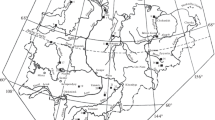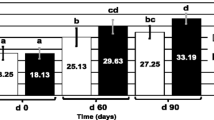Abstract
Storage of DDT [trichloro-bis-(p-chlorophenyl) ethane] residues by the shrew species,Blarina brevicauda andSorex cinereus, was studied in a 4.05-hectare old-field ecosystem, treated in June, 1969, with36Cl-ring-labeled DDT at a dosage of 0.92 kilograms per hectare. The mean radioactive DDT-derived residue contents ofBlarina liver (10 ppm), muscle (10 ppm), brain (4 ppm), and fat (135 ppm) of resident shrews were the same in 1970 and 1971, and they were not influenced by sex. Significant peaks occurred in the DDT residue content of fat in August, 1970 (243 ppm) and November, 1971 (236 ppm), which may have resulted from the consumption of slugs (Deroceras), whose population peaks coincided with the maximum residue levels of DDT in fat.Blarina released into the treated area accumulate DDT-derived residues in liver, brain, muscle, and fat comparable to the levels found in resident shrews, within 15 to 20 days of exposure to the area. Equilibrium between intake and excretion of DDT apparently occurs inBlarina liver, brain, and muscle within approximately 30 days and, in fat, within 40 days. InSorex, DDT residue levels in muscle and viscera reached peaks during the summer of DDT application (1969) and declined towards the end of the growing season, the pattern being similar to that found for the tissues ofBlarina. However,Sorex, unlikeBlarina, accumulated residue levels of DDT in 1970 and 1971 which were successively greater than the levels present in 1969, indicating that DDT probably was increasing in availability toSorex, with the passage of time. Mean levels of DDT residue in muscle (4 ppm) and viscera (3 ppm) are not influenced by sex but are influenced by breeding condition. Male shrews with scrotal testes and lactating females develop lower levels of DDT in muscle and viscera than males with abdominal testes or nonlactating females.
Similar content being viewed by others
References
Aulerich, R. J., R. K. Ringer, R. E. Bostrom, P. J. Schaible, and G. R. Hartsough: Heavy doses of pesticides can kill mink. Progress Rept. Mink Farmers Research Foundation, Milwaukee, Wisconsin, 8 p. (1968).
Bandy, L. W. (Ph.D. Thesis): The bioaccumulation and translocation of ring-labeled chlorine-36 DDT in an old-field ecosystem, Ohio State Univ., Columbus, 241 p. (1972).
Bandy, L. W., and T. J. Peterle: Transfer of Cl-36 DDT in a meadow. Third National Symposium on Radioecology, Oak Ridge, Tenn., USAEC, in press (1972).
Brown, J. H. U.: Influence of the drug DDD on adrenal cortical function in adult rats. Proc. Soc. Exp. Biol. Med.83, 2, 59 (1953).
Dale, W. E., T. B. Gaines, and W. J. Hayes: Storage and excretion of DDT in starved rats. Toxicol. Appl. Pharmacol.4, 89 (1962).
Dale, W. E., T. B. Gaines, and W. J. Hayes: Poisoning by DDT: Relation between clinical signs and concentration in rat brain. Science142, 1474 (1963).
Davis, B. N. K.: The soil macrofauna and organochlorine insecticide residues at twelve agricultural sites near Huntington. Ann. Appl. Biol.61, 29 (1968).
Davis, B. N. K., and M. C. French: The accumulation and loss of organochlorine insecticide residues by beetles, worms, and slugs in sprayed fields, Soil Biol. Biochem1, 45 (1969).
Deichmann, W. B., and M. L. Keplinger: Effect of combinations of pesticides on reproduction of mice. Toxicol. Appl. Pharmacol.8, 337 (Abstract) (1966).
Dimond, J. B., and J. A. Sherburne: Persistence of DDT in wild populations of small mammals. Nature221, 486 (1969a).
Dimond, J. B., and J. A. Sherburne: DDT persistence in wild hares and mink. J. Wildl. Manage.33, 944 (1969b).
Dimond, J. B., G. Y. Belyea, R. E. Kadunce, A. S. Getchell, and J. A. Blease: DDT residues in robins and earthworms associated with contaminated forest soils. Can. Entomol.102, 1122 (1970).
Dindal, D. L., and T. J. Peterle: Kinetics of Cl-36 DDT in wild waterfowl. Final Report RF 1970, Ohio State Univ., Columbus, 214 p. (1967).
Durham, W. F., C. Cueto, Jr., and W. J. Hayes, Jr.: Hormonal influences on DDT metabolism in the white rat. Amer. J. Physiol.18, 373 (1956).
Eadie, W. R.: Shrew-mouse predation during low mouse abundance. J. Mammal.29, 35 (1948).
Edwards, C. A.: Insecticide residues in soils. Residue Reviews13, 83 (1966).
Fitzhugh, O. G.: Use of DDT insecticides on food products. Ind. Eng. Chem.40, 704 (1948).
Fregly, M. J., I. W. Waters, and J. A. Straw: Effect of isomers of DDD on thyroid and adrenal function in rats. Can. J. Physiol. Pharmacol.46, 59 (1968).
Gentry, J. B.: Dynamics of an enclosed population of pine mice,Microtus pinetorum. Res. Pop. Ecol.X, 21 (1968).
Gilbert, F. F.: Physiological effects of natural DDT residues and metabolites on ranch mink. J. Wild. Manage.33, 933 (1969).
Gish, C. D.: Organochlorine insecticide residues in soils and soil invertebrates from agricultural lands. Pesticide Monit. J.3, 241 (1970).
Hamilton, W. J., Jr.: The food of the Soricidae, J. Mammal.11, 26 (1930).
Kaye, S. V.: Movements of harvest mice tagged with gold-198. J. Mammal.42, 323 (1961).
Morris, R. D.: Effects of endrin on survival and reproduction in the deer mouse,Peromyscus maniculatus. Can. J. Zool.46, 951 (1968).
Nash, R. G., and E. A. Woolson: Persistence of chlorinated hydrocarbon insecticides in soils. Science157, 924 (1967).
Ortega, P., W. J. Hayes, W. F. Durham, and A. Mattson: DDT in the diet of the rat. Public Health Monograph No.43, 1 (1956).
Ottoboni, A.: Effect of DDT on reproduction in the rat. Toxicol. Appl. Pharmacol.14, 74 (1969).
Peterle, A. F., and T. J. Peterle: The effect of DDT on aggression in laboratory mice. Bull. Environ. Contam. Toxicol.6, 401 (1971).
Randolph, J. C. (Ph.D. Thesis): Ecological energetics of a homeothermic predator. Carleton Univ., Ottawa, 135 p. (1971).
Rood, J. P.: Habits of the short-tailed shrew in captivity. J. Mammal.39, 499 (1958).
Rudge, M. R.: The food of the common shrewSorex araneus L. (Insectivora: Soricidae) in Britain. J. Anim. Ecol.37, 565 (1968).
Stickel, L. F., and W. H. Stickel: Distribution of DDT residues in tissues of birds in relation to mortality, body condition, and time. Proc. Sixth Inter—Am. Conf. Toxicol. Occup. Med. Miami, 33 p. (1968).
Turner, N.: DDT in Connecticut Wildlife. Connecticut Agric. Exp. Sta. Bull. No. 672, 11 p. (1965).
Ware, G. W., and E. E. Good: Effect of insecticides on reproduction in the laboratory mouse. II. Mirex, telodrin, and DDT. Toxicol Appl. Pharmacol.10, 54 (1967).
Woodwell, G. M., and F. T. Martin: Persistence of DDT in soils of heavily sprayed forest stands. Science145, 481 (1964).
Author information
Authors and Affiliations
Additional information
This research was supported by the U.S. Atomic Energy Commission, the Ohio Cooperative Wildlife Research Unit, and the Ohio Division of Wildlife.
Rights and permissions
About this article
Cite this article
Forsyth, D.J., Peterle, T.J. Accumulation of chlorine-36 ring-labeled DDT residues in various tissues of two species of shrew. Arch. Environ. Contam. Toxicol. 1, 1–17 (1973). https://doi.org/10.1007/BF02030141
Received:
Accepted:
Issue Date:
DOI: https://doi.org/10.1007/BF02030141




